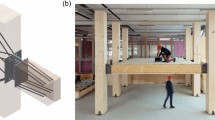Abstract
This research experimentally examined the strength, failure modes, and behaviors of dowel-bearing and fiber-bearing wood beam-column connections and explored the effects of cyclic loading on the strength, failure modes, and behaviors of those connections. Base on limited numbers of exploratory laboratory tests (6 preliminary tests in total), the authors observed that the typical bolted connection (dowel-bearing type wood beam-column connection with fiberbearing surfaces) showed good behavior (large peak moment) under the monotonic loads, and the tenon joint connection (fiber-bearing wood beam-column connection) showed good behavior under cyclic loads. The cyclic property of loading reduced the strength of the dowel-bearing type wood beam-column connections, but increased the strength of fiberbearing type wood beam-column connections. More importantly, the authors identified a possible location of safety concern in current national design specifications (NDS) standards for the typical bolted connection (dowel-bearing connection with fiber bearing surface) under cyclic loading because the tested value was smaller than the NDS calculated value. But, because of the small amount of tests conducted, no final conclusion can be drawn based on those preliminary observations yet. A large number of repetitive laboratory tests should be conducted.
Similar content being viewed by others
References
Li J. Ying Zao Fa Shi. Royal Press, Kaifeng, China (Song Dynasty), 1100 (in Chinese)
Ma B J. Construction Technology of Chinese Ancient Timber Architectures. 2nd ed. Beijing: Science Press, 2003 (in Chinese)
Song X, Lam F. Laterally braced wood beam-columns subjected to biaxial eccentric loading. Computers & Structures, 2009, 87(17–18): 1058–1066
Xing H, Xue S, Zong G. Dynamic properties of conventional beam-column timber structure under successive damage. Journal of Asian Architecture and Building Engineering, 2011, 202(1): 195–202
O’Loinsigh C, Oudjene M, Ait-Aider H, Fanning P, Pizzi A, Shotton E, Meghlat E M. Experimental study of timber-to-timber composite beam using welded-through wood dowels. Construction & Building Materials, 2012, 36: 245–250
Leijten A J M, Brandon D. Advances in moment transferring dvw reinforced timber connections-Analysis and experimental verification, Part 1. Construction & Building Materials, 2013, 43: 614–622
NDS. National Design Specification for Wood Construction ASD/LRFD. American Forest & Paper Association, Washington, DC, 2012
DCS. Deck Construction Specifications of the Building Department of the City of Lancaster, Lancaster, OH, 2004
ASTM E2126. Standard Test Methods for Cyclic (Reversed) Load Test for Shear Resistance of Walls for Buildings, American Society for Testing and Materials, West Conshohocken, PA, 2007
Author information
Authors and Affiliations
Corresponding author
Rights and permissions
About this article
Cite this article
Huang, Z., Shi, S.Q. & Cai, L. Experimental analysis on strength and failure modes of wood beam-column connections. Front. Struct. Civ. Eng. 8, 260–269 (2014). https://doi.org/10.1007/s11709-014-0261-y
Received:
Accepted:
Published:
Issue Date:
DOI: https://doi.org/10.1007/s11709-014-0261-y




